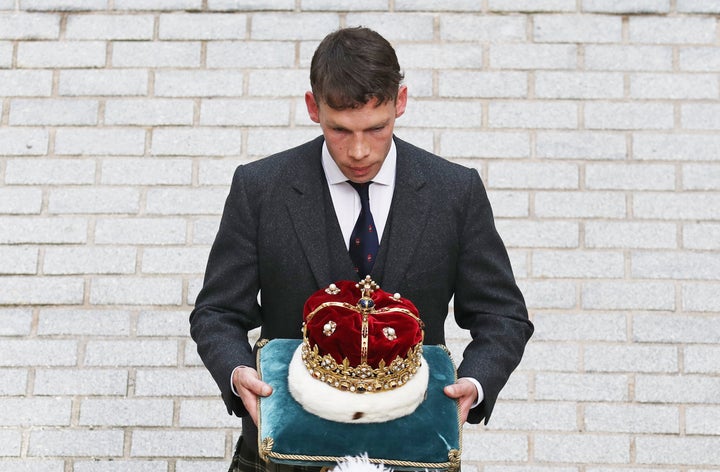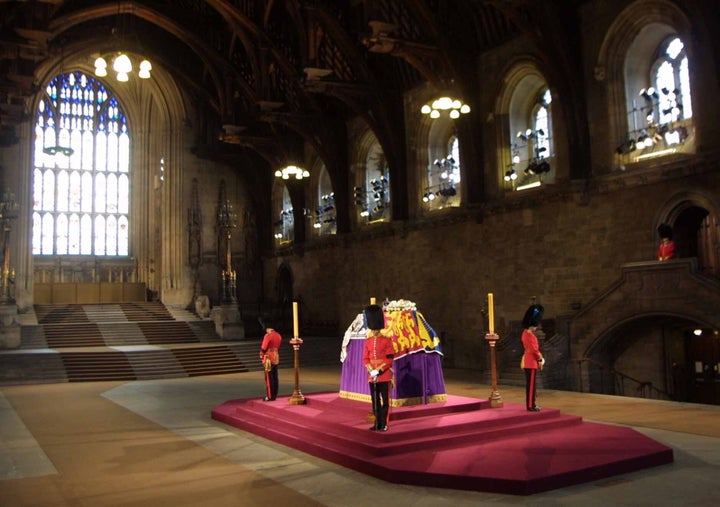
The Queen’s coffin will soon arrive in London, where it will lie in state from Wednesday until her funeral on September 19.
But what exactly does that mean?
Lying in state, explained
Lying in state is where the closed coffin of a high-ranking public figure – sovereigns, their consorts and occasionally ministers – is put on display for the public to pay their respects as they walk past.
The Queen’s lying in state will happen in Westminster Hall, after a ceremonial procession which will carry her body from Buckingham Palace. This will be screened in Hyde Park.
The hall will be open to the public from 5pm on Wednesday for 24 hours a day until it closes at 6.30am on Monday, September 19.
The Queen’s closed coffin will be covered in a flag, The Royal Standard, and will be on a raised platform called catafalque, with military guard – made up of the Sovereign’s Bodyguard, Yeoman Warders of the Tower of London or the Household Division – standing at each of the four corners of the platform 24 hours a day.
The royal orb and sceptre will also be placed on top of the coffin.
The Queen’s children or grandchildren may join the guard over the coffin, in a tradition called the Vigil of the Princes. If Princess Anne takes part, she’ll be the first female member of the family ever to do so.
Difference from lying in rest
Before lying in state in London, the Queen will be lying in rest in Edinburgh, after completing the more than six-hour journey from Balmoral – where she died – to the Palace of Holyroodhouse.
The procession from Holyroodhouse to St Giles’ Cathedral, led by King Charles and his siblings, will end at 2.55pm on Monday.
The Crown of Scotland will be placed on the coffin from 5pm and the general public will be able to visit.

Her coffin will then be flown down to the capital, a shift from the original plans where she was supposed to travel via the Royal Train down south.
Lying at rest is less formal, and happens when the body is not at its principle residence.
The Queen’s body will remain there until Tuesday, when Princess Anne will accompanied it on the plane to London.
History of lying in state

The concept began in the 17th Century, during the Stuart era, but only Edward VII – the eldest son of Queen Victoria – set up the traditions as we know them today. He was the Queen’s great-grandfather.
Every monarch since his death in 1910 has lay in state.
Prime ministers William Gladstone and Sir Winston Churchill also both lay in state, as did the victims of the R101 Airship disaster in 1930.
The Queen’s husband the Duke of Edinburgh died in 2021, but he did not lie in state as per his own request. Mass gatherings during this period of the pandemic were also not permitted to reduce transmission of Covid.
The Queen Mother was the last person to lie in state back in 2002. Her coronation crown was placed upon her coffin, and a hand-written message from the Queen which read: “In loving memory, Lilibet.”
As it was the first time a security check was included, the queue of an estimated 200,000 people reached along Lambeth Bridge and back to Southwark Cathedral.
People were expected to wait for up to 12 hours at peak time, and the police were even called in for crowd management.
Why Westminster Hall?
Dating back to 1099, the building is inside the Palace of Westminster and the oldest building in the parliamentary estate.
It forms part of the Westminster Unesco World Heritage site.
It has had a key role in many significant historical events such as the trial of King Charles I, coronation banquets and addresses from world leaders.
Warnings to those waiting
Aside from road closures and delays on public transport, tight security will add to the queues waiting to see the Queen’s coffin, meaning some people may have to wait overnight.
According to The Times, some people might be waiting for up to 20 hours, and there are fears that up to 750,000 mourners may all come to London for the occasion – meaning the Cabinet Office are supposedly preparing for the capital to become “full” for the first time.
People are encouraged to plan ahead accordingly before they reach the airport-style security measures.
Mourners will only be allowed to take a small bag (40cm x 30cm x 20cm) with a simple opening, although large bags can be stored at a limited-capacity facility – waiting to store your bags will increase your queuing time too.
Officials also recommend people bring suitable clothes for any weather, food and drink, a portable power bank for your phone and medication.
People have been asked to dress appropriately – no clothes with political slogans, for instance – and are advised not to film, take photos, use their phones or other handheld devices within the palace or in the security search area.
Do not bring flowers, candles, soft toys or photographs, banners, flags, hampers, blankets and folding chairs, either. Flowers can only be placed in the dedicated area of Green Park.
There might be five miles worth of queues, and people will have little option to sit down.
The official guidance added: “Please consider this before you decide to attend or bring children with you.”
All food and drink must be consumed or disposed of being entering the palace. Flasks and water bottles are banned, unless they’re clear. Sharp items, paint sprays, padlocks, chains, climbing gear and other hazardous object are banned too.
There will be step-free access available.
Wristbands will be given to people at the end of the queue and only those with a wristband can stay – people can not queue on others’ behalf.
Mourners have been asked to “respect the dignity of this event” and stay silent in the actual Palace of Westminster. Queue-jumping, excessive consumption of alcohol will not be tolerated and people could be removed from the queue.
For those who can’t make it to see the coffin, key moments of the ceremonial procession and lying in state will be broadcast on BBC, Sky News and ITV.
